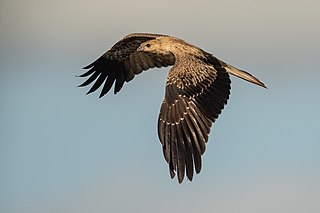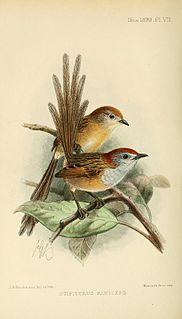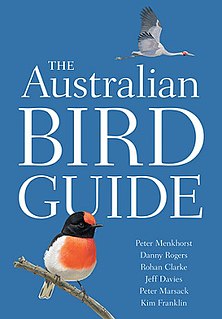
The azure kingfisher is a small kingfisher in the river kingfisher subfamily, Alcedininae.

The eastern spinebill is a species of honeyeater found in south-eastern Australia in forest and woodland areas, as well as gardens in urban areas of Canberra, Sydney and Melbourne. It is around 15 cm long, and has a distinctive black, white and chestnut plumage, a red eye, and a long downcurved bill.

The whistling kite is a medium-sized diurnal raptor found throughout Australia, New Caledonia and much of New Guinea. Also called the whistling eagle or whistling hawk, it is named for its loud whistling call, which it often gives in flight. Some authorities put this species in the genus Milvus, despite marked differences in behaviour, voice and plumage between this species and other members of that genus.

The topknot pigeon is a pigeon native to eastern Australia.

The white-cheeked honeyeater inhabits the east coast and the south-west corner of Australia. It has a large white patch on its cheek, brown eyes, and a yellow panel on its wing.
Graham Martin Pizzey AM was a noted Australian author, photographer and ornithologist.

The red-backed kingfisher is a species of kingfisher in the subfamily Halcyoninae, also known as tree kingfishers. It is a predominantly blue-green and white bird with a chestnut rump. It is found across the continent of Australia, mainly inhabiting the drier regions.

The pale-vented bush-hen is a medium sized waterbird, mainly blue-grey with a buff vent and undertail. It is found in Australia, the Moluccan Islands, New Guinea, the Bismarck Archipelago and the Solomon Islands. Its natural habitat is subtropical or tropical moist lowland forests.

The banded honeyeater is a species of honeyeater in the family Meliphagidae with a characteristic narrow black band across its white underparts. It is endemic to tropical northern Australia.

The white-fronted chat is a species of bird in the honeyeater family Meliphagidae native to southern Australia. The male has a white face bordered by a black breast band. It is insectivorous.

The pictorella mannikin, pictorella munia, or pictorella finch is small brown and grey finch with a grey bill and distinctive scaly white breast plate which is endemic to northern Australia. It is a seed-eater found in pairs and small flocks in dry savannah and subtropical or tropical dry lowland grassland.

The shy heathwren is a species of small bird in the family Acanthizidae, endemic to Australia. They inhabit mostly mallee woodland that has relatively dense shrub and heath understorey. Shy heathwrens feed mostly on ground dwelling insects, and rarely on seeds. Their ground level nests are dome-shaped and usually concealed within grass tussocks or shrubs. Within the nest they typically lay 2–3 freckled and pinkish eggs.

The bridled honeyeater is a species of bird in the family Meliphagidae with distinctive rein-like markings on its face that is endemic to northeastern Queensland. It is found in subtropical or tropical moist upland forests and subtropical or tropical rainforests, usually above 300 meters. In winter, it descends to lower forests including mangroves, and can sometimes be seen in more open habitats.

The chestnut-crowned babbler is a medium-sized bird that is endemic to arid and semi-arid areas of south-eastern Australia. It is a member of the family Pomatostomidae, which comprises five species of Australo-Papuan babblers. All are boisterous and highly social, living in groups of up to 23 individuals that forage and breed communally. Other names include red-capped babbler, rufous-crowned babbler and chatterer.

The emu-wrens (Stipiturus) are a genus of passerine birds in the Australasian wren family, Maluridae. They are found only in Australia, where they inhabit scrub, heathland and grassland. They are small birds, 12–19 cm long with the tail accounting for over half of their length. The tail has only six feathers which are loose and coarse in structure, rather like the feathers of the emu. Three species are recognised, of which the mallee emu-wren is endangered.
A Field Guide to Australian Birds is a two-volume bird field guide published by Rigby of Adelaide, South Australia, in its Rigby Field Guide series. The first volume was issued in 1970, with the second volume appearing in 1974. It was Australia’s first new national bird field guide since the 1931 publication of the first edition of Neville Cayley’s What Bird is That?. It was principally authored by Australian ornithologist, artist and photographer Peter Slater.
Frank Knight is an Australian wildlife artist and ornithologist. He was born in Port Hedland, Western Australia. He worked as a field and laboratory assistant for the CSIRO from 1959 to 1966, and was the illustrator for the CSIRO's Division of Wildlife Research from 1966 until 1989. He was the illustrator of The Graham Pizzey and Frank Knight Field Guide to the Birds of Australia and A Field Guide to the Mammals of Australia, as well as of many other scientific and natural history texts and children's books. He has had several solo exhibitions in Australia.

A Field Guide to the Birds of Australia was first published in 1980 by Collins, Sydney. It was authored by Graham Pizzey with illustrations by Roy B. Doyle. The first edition was issued in octavo format, 220 mm in height by 140 mm width, with a foreword by Dr D.L. Serventy. It contained 460 pages of text with 32 black-and-white and 56 colour plates illustrating nearly all species of birds recorded in Australia at the time of publication. The plates were bunched between pages 300 and 301, while there were 725 maps of breeding distribution on pages 411-442 between the main text and the indexes, as well as maps of Australia in the end papers. Its success was such that it was followed by several further editions.
Peter Slater was an Australian ornithologist, wildlife artist and photographer.

The Australian Bird Guide was published by CSIRO Publishing in 2017 and took almost 8 years to produce. The lead author is Peter Menkhorst along with Danny Rogers and Rohan Clarke. Original illustrations are by Jeff Davis, Peter Marsack and Kim Franklin.
















